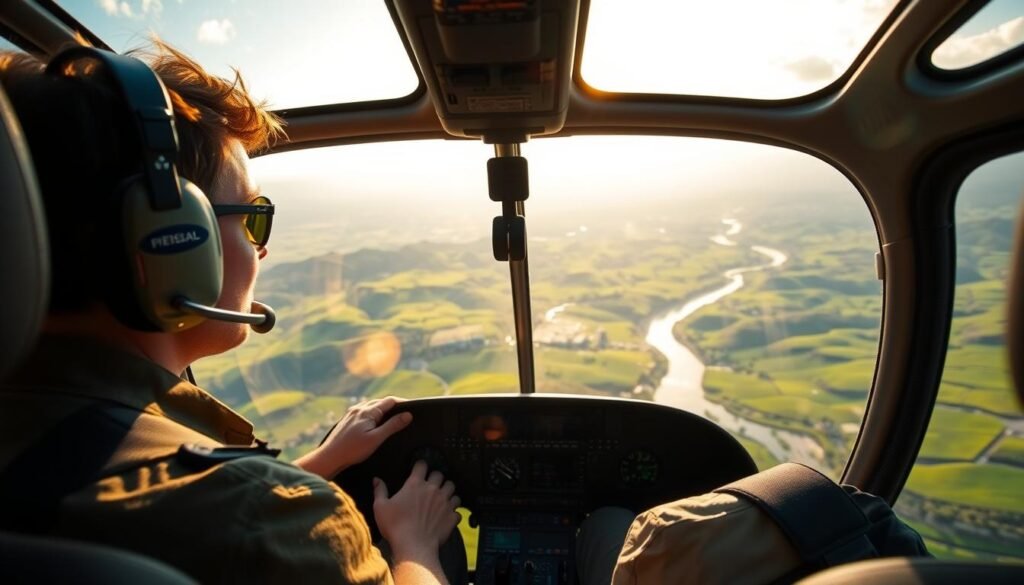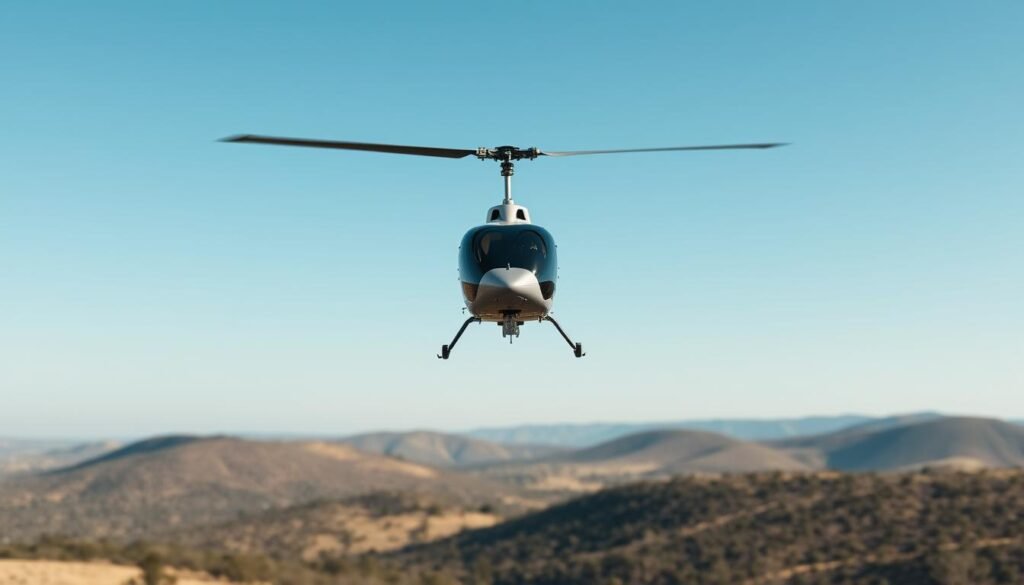Do Helicopters Have Parachutes opens a counterintuitive question that often surprises readers: when an engine fails, should occupants jump or trust the aircraft?
The short answer is that typical civilian rotorcraft do not carry personal parachutes. Pilots rely on autorotation, a controlled, engine-off descent that puts the aircraft back on the ground safely when handled correctly.
Practical constraints shape this choice. Spinning main and tail rotor blades, low operating altitudes, brief reaction time, and multiple occupants make midair bailouts risky or impossible in most situations.
Still, notable exceptions exist. The Curti Zefhir fits a whole-aircraft ballistic chute, and the Russian KA-52 uses blade-shedding and ejection seats for combat missions. Test pilots in high-altitude trials sometimes use personal parachutes, as in a Robinson R22 certification bailout at 10,000 ft.
This article will explain the rotorcraft systems, myth versus reality, emergency procedures, and when a parachute solution is even feasible. Readers will get clear, step-by-step explanations to judge risk, safety, and design trade-offs.
Key Takeaways
- Most civilian helicopters rely on autorotation rather than personal parachutes.
- Rotor hazards, low altitude, and multiple occupants make bailouts impractical.
- Special systems like the Zefhir chute and KA-52 ejection exist in niche designs.
- Emergency planning emphasizes controlled descent and trained pilot actions.
- Technology choices balance weight, cost, training, and real safety gains.
Do Helicopters Have Parachutes? Understanding Emergency Safety Systems
A helicopter keeps occupants inside the cabin during most emergencies because leaving the aircraft exposes them to the spinning rotor and tail systems. Remaining aboard and flying a controlled recovery gives the best chance of survival in typical operations. Autorotation is the engineered recovery method that lets the rotor continue to spin and absorb energy after engine loss.
Key Facts: Why Most Helicopters Do Not Use Parachutes
Rotor blades create a lethal sweep above and behind the cabin. At low altitudes common in many flights, there is not enough time or clearance to exit and inflate a canopy safely.
Deploying a canopy is impractical for multi‑passenger flights and adds weight and maintenance burden to systems designed for autorotation. Specialized solutions exist, but they are niche and require major design changes.
Common Misconceptions About Parachutes, Helicopters, And Safety
People often assume a parachute equals universal safety in aviation. In rotorcraft operations, that logic fails because altitudes, rotor hazards, and evacuation complexity differ from fixed‑wing flight.
- Autorotation is built into most aircraft and is the primary emergency strategy.
- Some designs, like whole‑aircraft chutes or military ejection systems, are exceptions and carry trade‑offs.
- Readers evaluating new products should ask how a system handles blades, altitudes, and normal operations.
For a practical review of safety claims and common myths, see this detailed discussion on helicopter misconceptions: How Safe Are Helicopters?
How Helicopters Handle Emergencies: Autorotation, Altitude, And Pilot Procedures
Pilots rely on energy stored in the spinning rotor to manage a descent after sudden power loss. That planned procedure, autorotation, frees the main rotor from the engine and lets upward airflow keep RPM steady.

Autorotation Explained: Using The Main Rotor As A Recovery System
When the freewheeling unit disconnects the drive, the rotor turns from airflow during descent. The pilot balances airspeed and rotor RPM to preserve stored energy. Near touchdown they flare, typically between 50 and 200 feet, converting rotor energy into a softer landing.
Altitude, Airspeed, And Time: Limits On Parachute Deployment
Low operating altitude and short reaction time make canopy use impractical. There is rarely enough time for a canopy to inflate clear of the rotor blades or to reach safe ground impact speeds.
Passenger Safety, Cockpit Layout, And Operational Realities
Cabin layout and door access complicate any midair exit. Crew training and checklist discipline focus on autorotation as the primary recovery course for most helicopter flight emergencies.
Test Flights And Parachute Use: When Pilots Wear Canopies
In high‑altitude stress tests, pilots may wear canopies as a last resort. Such bailouts require altitude, a clear exit, and coordinated action to be survivable.
How To Evaluate Parachute And Ejection Options In Helicopters
Evaluating escape concepts for small rotorcraft requires clear, measurable criteria. Teams must compare weight, timing, and the likelihood that a system will improve a failed‑engine outcome.

Whole-Aircraft Parachute Systems: Zefhir’s Ballistic Deployment Approach
The Curti Zefhir stores a ballistically fired canopy in a pod above the mast so the parachute clears the main rotor path on deployment.
This design is viable on light two‑seat airframes because added mass and drag are manageable. Structural reinforcement and careful canopy path planning are essential.
Ejection Seats In Rotorcraft: KA-52 Blade-Shedding And Pilot Recovery
The KA‑52 uses explosive bolts to jettison blades, then fires rocket seats to clear the airframe. That sequence makes seats effective only in specialized, military aircraft.
“Ejection in a rotor environment requires blade‑shedding before seat firing—there is no safe shortcut.”
Such systems are heavy, costly, and tailored to mission risk rather than general civil operations. Maintenance on rocket motors and release mechanisms is critical.
Practical Checklist: When Parachute Systems Add Value Versus Autorotation
Key items to assess:
- Typical altitude and reaction time (feet and seconds to canopy inflation).
- Mission profile and likely landing zones versus autorotation margins.
- Training needs for pilots and occupants and revised cockpit procedures.
- Airframe fit: mounting, rotor clearance, structural loads, and power penalties.
- Maintenance demands for the recovery system, rockets, and canister condition.
| Option | Best Fit Airframe | Primary Benefit | Main Constraint |
|---|---|---|---|
| Whole‑aircraft parachute | Light two‑seat | Alternative recovery when autorotation not possible | Weight, drag, rotor clearance |
| Ejection seats | Military rotorcraft | Rapid occupant clearance after blade jettison | Cost, complexity, maintenance |
| Autorotation | Most civil aircraft | Proven, no extra systems | Requires pilot training and altitude |
Bottom line: parachute solutions and seats are specialized tools. They can add safety in narrow cases, but autorotation and disciplined training remain the most reliable recovery approach for routine operations. For technical context on ejection seats, see ejection seat mechanics.
Conclusion
Conclusion
Most emergency protocols for rotorcraft center on preserving rotor energy and executing controlled descents. Autorotation, backed by recurrent training, gives pilots the best chance to turn an engine failure into a survivable landing.
While whole‑aircraft parachute pods and rocket seats exist in niche models, operational limits — rotor hazards, low altitude, and limited time to inflate a canopy — keep such systems rare in routine operations.
Good flight planning, briefed cockpit roles, and practiced procedures matter most. For additional reading on rotorcraft facts and safety context, see this quick facts page: Top Helicopter Facts.
Bottom line: technology can help in select cases, but pilot skill, checklist discipline, and autorotation remain the primary means to protect lives during rotorcraft flight.
FAQ
Do most helicopters carry whole-aircraft parachute systems?
Most rotorcraft do not carry whole-aircraft parachutes. Small fixed-wing aircraft often use ballistic recovery systems, but the main rotor of a helicopter complicates canopy deployment and safe inflation. Manufacturers and operators rely on rotorcraft-specific recovery methods instead of widespread parachute installation.
What recovery method do pilots use when the engine fails?
Pilots perform autorotation. That technique lets the main rotor keep spinning from upward airflow while the aircraft descends, enabling a controlled landing. Proper training, immediate pilot action, and suitable altitude are critical for a successful autorotation touchdown.
At what altitudes could a parachute system be effective for a helicopter?
Parachutes need sufficient altitude and time to deploy and slow descent. Typical effective deployment requires several hundred to a few thousand feet, depending on the system. Many helicopter emergencies occur too low or too fast for safe canopy inflation.
Are there certified whole-aircraft parachute options for rotorcraft?
A few companies have developed rotorcraft parachute systems that address rotor interference and rapid deployment, but certification is limited and application-specific. Installation adds weight and alters performance, so certification, cost, and operational trade-offs restrict adoption.
Do any helicopters use ejection seats like some military jets?
Some military attack helicopters, such as the Kamov Ka-52, use blade-shedding mechanisms and ejection seats to clear the rotor before seat ejection. These systems are complex, heavy, and tailored to specific airframes, so they are not common in civilian rotorcraft.
Can passengers deploy a parachute from inside a helicopter?
No. Whole-aircraft parachutes deploy externally and are not user-operated from passenger seats. Personal parachutes are not practical inside most cabins because cabin layout, doors, and rotorcraft operating speeds make midair exit dangerous or impossible.
When do pilots wear personal parachutes during helicopter operations?
Pilots may wear parachutes during test flights, high-altitude training, or special military missions where egress is possible. In normal civilian operations, personal parachutes are rarely used because controlled autorotation and emergency landing procedures are the preferred safety measures.
How does rotor speed and blade rotation affect parachute deployment?
Rotating blades present major hazards: they can tangle or destroy a deploying canopy. Effective whole-aircraft systems must prevent canopy contact with blades or rapidly neutralize rotor motion. That complexity makes reliable deployment under many failure scenarios difficult.
What are the maintenance and weight implications of adding a parachute system?
Installing a ballistic recovery or similar system increases weight, shifts center of gravity, and requires extra maintenance, inspections, and potential structural reinforcements. These impacts reduce useful load and can change performance, so operators must weigh safety benefits against operational penalties.
How should operators decide between parachute systems and relying on autorotation?
Decision-makers evaluate mission profile, typical operating altitudes, aircraft type, cost, and certification. For many civilian missions, autorotation, pilot training, and robust emergency procedures provide the best risk-reduction. In specialized applications, whole-aircraft recovery or ejection solutions may add meaningful safety margins.
What training do pilots receive for parachute-equipped helicopters?
Training covers system activation, emergency procedures, and post-deployment actions. Pilots learn altitude and airspeed limits for deployment, checklist flows, and evacuation protocols. Regular simulator and practical training ensures crews can decide quickly during time-critical failures.
Are there real-world examples where a parachute saved rotorcraft occupants?
Documented cases exist where ballistic systems saved occupants in light aircraft, but verified helicopter parachute saves are rare due to engineering challenges. Military ejection systems have preserved crews in specific circumstances, demonstrating the principle when aircraft design addresses rotor hazards.
How does speed affect the chance of successful parachute deployment?
High forward speed increases canopy inflation loads and risk of entanglement. Parachute deployment at high airspeed can produce severe forces on the airframe and occupants. Systems must be designed to handle these loads or be limited to lower-speed scenarios to be effective.
What is the role of canopy type and deployment mechanism in rotorcraft recovery?
Canopy design and rapid deployment mechanisms determine how quickly and reliably a system decelerates the airframe. Ballistic deployment uses a rocket to extract the canopy rapidly, reducing required altitude and time. Systems must also manage opening shock to protect the structure and occupants.
Can retrofitting a parachute system be done on older models?
Retrofitting is possible in limited cases but requires engineering approval and may need structural changes, weight-and-balance recalculation, and regulatory certification. Each airframe demands a tailored installation, and not every older model qualifies for retrofit.
What operational situations make parachute systems most valuable?
Parachutes add value in single-engine, low-power scenarios over terrain where a forced landing poses high risk, or for missions that operate at altitudes where deployment is feasible. They also offer an extra layer of safety during test flights and experimental operations.loped, the current focus in helicopter safety is on pilot training and emergency preparedness, ensuring that helicopters remain among the safest and most versatile aircraft in the skies.
Related Articles
- Can Anyone Learn to Fly a Helicopter? Understanding Training and Skills Required
- Why Do Helicopters Make That Distinctive Sound? Helicopter Noise Explained
- Do Helicopters Require More Maintenance Than Airplanes? Separating Fact from Fiction
- How Far Can Helicopters Travel? Dispelling Range Myths
- What Happens if a Helicopter Engine Fails? Debunking Catastrophe Myths
More from This Category
- Are Helicopters More Dangerous Than Planes? A Safety Comparison
- Do Helicopters Have Parachutes? Exploring Emergency Systems
- Can Helicopters Fly Upside Down? The Truth Behind Aerobatic Stunts
- Do Helicopters Need a Runway? Myth vs. Reality
- How Much Does It Really Cost to Fly a Helicopter? Busting the Myths
- How High Can Helicopters Fly? Debunking Altitude Myths
- Can Helicopters Fly in Bad Weather? Understanding Helicopter Capabilities
- Do Helicopters Really Hover Forever? Separating Fact from Fiction
- How Safe Are Helicopters? Debunking Common Misconceptions
- Top 10 Myths About Helicopter Safety: What You Need to Know



